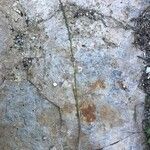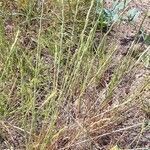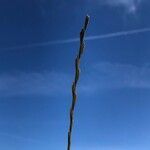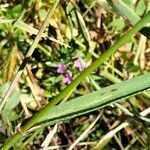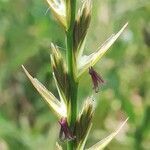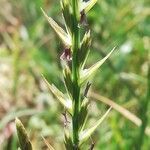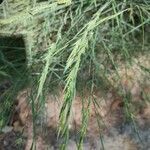Annual. Culms 15–100 cm high, occasionally rooting at nodes above base; mid-culm nodes and internodes sometimes pigmented. Leaves non-auriculate or narrowly auriculate; basal sheaths usually purple, becoming straw-coloured; blade convolute in bud, 8–24 cm long, 3.8–5 mm wide. Spike 11–23 cm long, with 12–30 spikelets; axis slender or thick, 1.3–2.6 mm wide, with angles scabrous. Spikelets usually partially concealed by glume, 1–1.5 spikeletlengths apart in mid-axis, 7–18 mm long, 2–5 mm wide, with 4–7 bisexual florets; rachilla segments 2.1–2.6 mm long. Glume c. 3/4 length of spikelet to about equalling spikelet, slightly shorter than to longer than basal lemma; upper glume narrowly ovate to lanceolate, 6.8–15 mm long, 5–7-nerved. Lemma dorsally compressed, 4.7–8.8 mm long, awnless or rarely distal lemmas with awn to 1 mm long, membranous, 5-nerved, sometimes pigmented toward apex and/or margins. Caryopsis ellipsoid, not grooved, 4.7–5.5 mm long, 1.3–1.7 mm wide.
Annual. Culms tufted, erect or geniculate at base, 20–80 cm tall, 2–4-noded, smooth or scabrid below inflorescence. Leaf blades 5–20 cm × 3–6 mm, adaxial surface and margins smooth or scabrid, abaxial surface smooth; auricles up to 3 mm or absent; ligule 0.5–2.5 mm, rounded or truncate. Raceme stiff, straight or curved, 5–20 cm; rachis slender to fairly stout, smooth or scabrid, 1–3 mm thick, spikelets appressed to partly sunken, overlapping by half their length or up to their own length apart. Spikelets 1–2 cm, florets 5–10; glume lanceolate to oblong, as long as spikelet, 5–7(–9)-veined; lemmas oblong or oblong-lanceolate, 5–8 mm, 3–5-veined, scabrid, apex obtuse or erose; awn absent or 3(–8) mm on upper fertile florets only. Caryopsis length 3 times width or more.
Tufted annual, 100-300(-500) mm high; many flowering culms or solitary; culms in young plants branching near base, sometimes rooting from lower nodes. Leaf blade 100-170 x 5-8 mm; ligule an unfringed membrane. Inflorescence a spike with spikelets sunk and lying edgeways in partial cavities on alternate sides of central axis. Spikelet 7-20 x 1-3 mm; upper glume appressed to rachis, slightly gaping at maturity, 3/4 to slightly longer than spikelet, concealing or partly concealing spikelet. Florets 2; lemma obtuse to acute, not turgid at maturity, awn absent or up to 10 mm long; palea as long as lemma, 2 rough keels; anther 1.4-1.7 mm long. Flowering time Sept.-Jan. Caryopsis when mature > 3x as long as wide.
Tufted annual 100-300(-500) mm high; solitary or numerous flowering culms, culms in young plants branching near the base and sometimes rooting from the lower nodes. Leaf blade 100-170 x 5-8 mm. Spikelet 7-20 x 1-3 mm; 2-flowered; upper glume adpressed to the rachis, slightly gaping at maturity, 3/4 to slightly longer than spikelet, concealing or partly concealing the spikelet in a concavity of the rachis; lemma obtuse to acute, not turgid at maturity, awn absent or to 10 mm long; palea as long as lemma, keels 2, rough; anther 1.4-1.7 mm long; mature caryopsis more than three times as long as wide.
Annual, tufted (with numerous flowering culms or solitary culms in young plants; culms branching near base and sometimes rooting from lower nodes), up to 300 mm tall. Leaf blades 100-170 mm long, 5-8 mm wide. Spikelets 7-20 mm long, 1-3 mm wide, 2-flowered; glumes appressed to rachis, slightly gaping at maturity, concealing or partly concealing spikelets in concavities of rhachis, three-quarters of to slightly longer than spikelets; lemmas obtuse to acute, not turgid at maturity, awn absent or to 10 mm long. Mature caryopsis more than 3 times as long as wide.
An annual grass. It is less than 30 cm high. The stems are reddish in colour. It produces both flowering and non flowering shoots. The leaves are flat and 20 cm long. They are 8 mm wide and hairless. The flowers are in spikes that are shorter than the stems. There are 3-11 florets per spikelet. The spikes are open at maturity.
Annual to 30 cm. Leaves linear. Spikelets in a simple spike, embedded in rachis, 1-3 mm wide, partly concealed by appressed glumes, awned or awnless.
